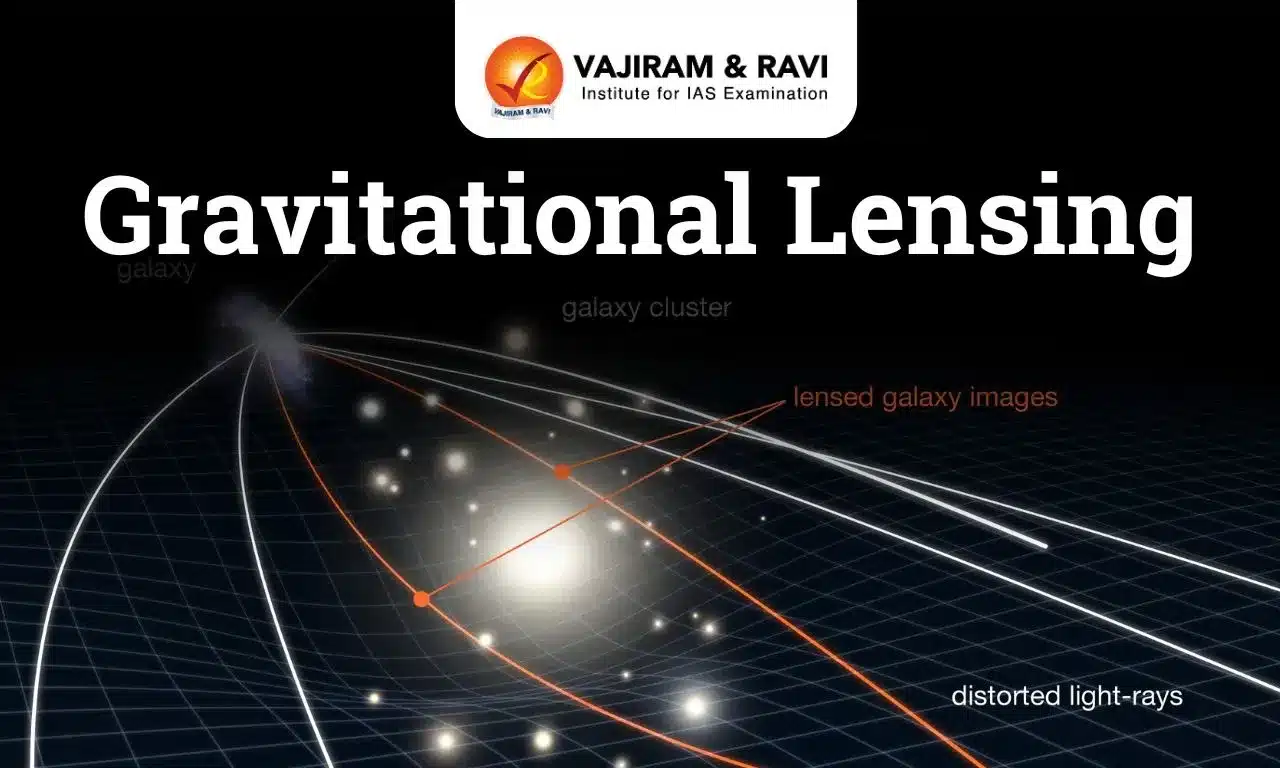About Gravitational Lensing:
- Gravitational Lensing is an effect on light from a background source that arises as a result of the curvature of spacetime, the three dimensions of space and time united into a single entity, caused by mass.
- Gravitational Lensing causes the light to bend, distort, and magnify as it passes around the massive object.
- Gravitational Lensing Theory:
- Gravitational Lensing was first predicted in 1915 by Albert Einstein, which involves the bending of light by objects of great mass.
- According to Einstein’s general theory of relativity, time and space are fused together in a quantity known as spacetime.
- Within this theory, massive objects cause spacetime to curve, and gravity is simply the curvature of spacetime.
- As light travels through spacetime, the theory predicts that the path taken by the light will also be curved by an object’s mass.
- Gravitational Lensing is a dramatic and observable example of Einstein’s theory in action.
- The effect is most observable when light from a bright background source, like a star, a quasar, or an entire galaxy, passes a very massive object like another galaxy or a cluster of galaxies, described as a lensing object or just a gravitational lens.
- This can have several results; it can make an object shift its apparent position in the sky over Earth, or it can cause a single object to appear at multiple points in the sky, occasionally giving rise to spectacular formations like rings and crosses made from the same object.
- More than this, Gravitational Lensing can actually cause the lightfrom a background object to be amplified.
- That means that astronomerscan use the Gravitational Lensing arising from galactic clusters as natural cosmic magnifying glasses.
- This has made it an important tool for the investigation of the universe when it was in its infancy, making light from the earliest galaxies that would usually be too faint to see observable by instruments like the James Webb Space Telescope and the Hubble Space Telescope.
Q1: What is the James Webb Space Telescope?
The James Webb Space Telescope (JWST) is a monumental leap in space exploration and astrophysics. Launched on December 25, 2021, it is the largest and most powerful space telescope ever built, serving as the premier space-based observatory for the next decade. Developed by NASA with contributions from the European and Canadian space agencies, JWST is designed to observe the universe primarily in the infrared spectrum.
Source: MSN
Last updated on December, 2025
→ Check out the latest UPSC Syllabus 2026 here.
→ Join Vajiram & Ravi’s Interview Guidance Programme for expert help to crack your final UPSC stage.
→ UPSC Mains Result 2025 is now out.
→ UPSC Notification 2026 is scheduled to be released on January 14, 2026.
→ UPSC Calendar 2026 is released on 15th May, 2025.
→ The UPSC Vacancy 2025 were released 1129, out of which 979 were for UPSC CSE and remaining 150 are for UPSC IFoS.
→ UPSC Prelims 2026 will be conducted on 24th May, 2026 & UPSC Mains 2026 will be conducted on 21st August 2026.
→ The UPSC Selection Process is of 3 stages-Prelims, Mains and Interview.
→ UPSC Result 2024 is released with latest UPSC Marksheet 2024. Check Now!
→ UPSC Prelims Result 2025 is out now for the CSE held on 25 May 2025.
→ UPSC Toppers List 2024 is released now. Shakti Dubey is UPSC AIR 1 2024 Topper.
→ UPSC Prelims Question Paper 2025 and Unofficial Prelims Answer Key 2025 are available now.
→ UPSC Mains Question Paper 2025 is out for Essay, GS 1, 2, 3 & GS 4.
→ UPSC Mains Indian Language Question Paper 2025 is now out.
→ UPSC Mains Optional Question Paper 2025 is now out.
→ Also check Best IAS Coaching in Delhi

















